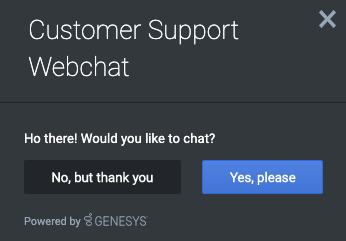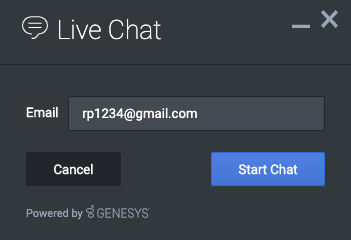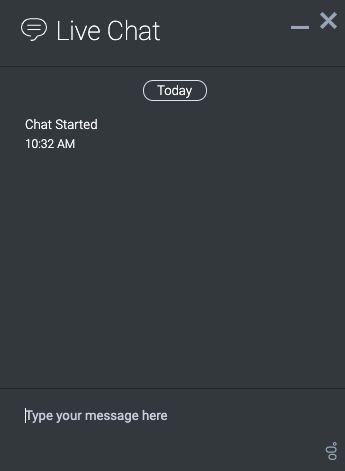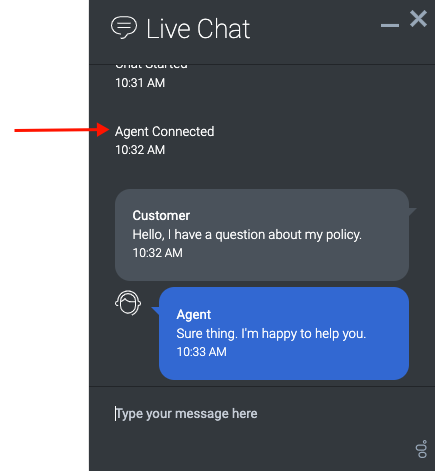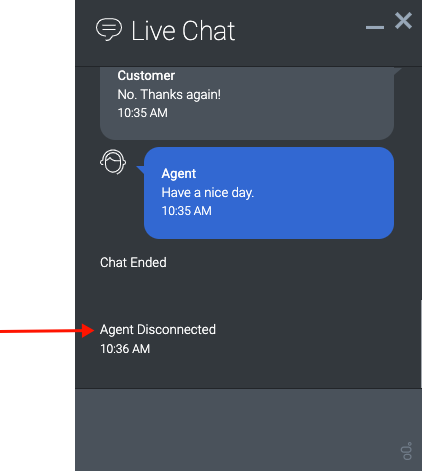Difference between revisions of "ATC/Current/SDK/Web chat lifecycle"
DannaShirley (talk | contribs) (Published) |
DannaShirley (talk | contribs) (Published) |
||
| Line 1: | Line 1: | ||
{{Article | {{Article | ||
|Standalone=No | |Standalone=No | ||
| − | |DisplayName=Web | + | |DisplayName=Web chat lifecycle |
| − | |TocName=Web | + | |TocName=Web chat lifecycle |
|Context=See the lifecycle of a web chat and the metrics that we capture at each state along the way. Lifecycle states are used in reporting and in determining the triggering behavior of action maps that use web chats. | |Context=See the lifecycle of a web chat and the metrics that we capture at each state along the way. Lifecycle states are used in reporting and in determining the triggering behavior of action maps that use web chats. | ||
|Dimension=WebActions | |Dimension=WebActions | ||
| Line 14: | Line 14: | ||
|Media= | |Media= | ||
|image= | |image= | ||
| − | |structuredtext=The following diagram shows the | + | |structuredtext=The following diagram shows the stages that occur during the lifecycle of {{Link-SomewhereInThisVersion|manual=AdminGuide|topic=Chat_offers|display text=web chats}}. Subsequent sections provide details about specific states, including the events that can occur and the data that is available for use with the {{Link-SomewhereInThisVersion|manual=SDK|topic=Use_Events_methods_with_web_actions|anchor=WebActionMethods|display text=Events methods for web actions}}. The section, {{Link-SomewhereInThisVersion|manual=SDK|topic=Web_chat_lifecycle|anchor=Terminal|display text=Terminal states}}, explains how states ensure that customers do not repeatedly see the same offer to chat. |
| − | + | [[File:Lifecycle.png]] | |
| − | |||
| − | |||
| − | |||
| − | |||
| − | |||
| − | |||
| − | |||
| − | |||
| − | |||
| − | |||
|structuredtextwide= | |structuredtextwide= | ||
|FAQHeading= | |FAQHeading= | ||
| Line 35: | Line 25: | ||
|Media= | |Media= | ||
|image= | |image= | ||
| − | |structuredtext=[[File:1ChatInvite.png | + | |structuredtext=[[File:1ChatInvite.png|frameless|346x346px]] |
| − | |||
{{{!}} class="wikitable" | {{{!}} class="wikitable" | ||
| − | |||
!State | !State | ||
!Event | !Event | ||
| Line 56: | Line 44: | ||
{{!}}rejected | {{!}}rejected | ||
{{!}}Web Actions Rejected | {{!}}Web Actions Rejected | ||
| − | {{!}}The customer rejects the invitation by either clicking '''X''' or a button like, '''No, but thank you'''. | + | {{!}}The customer rejects the invitation by either clicking '''X''' or a button like, '''No, but thank you'''. This is a {{Link-SomewhereInThisVersion|manual=SDK|topic=Web_chat_lifecycle|anchor=Terminal|display text=terminal state}}. |
{{!}}See {{Link-SomewhereInThisVersion|manual=SDK|topic=Use_Events_methods_with_web_actions|anchor=EventsWebActions|display text=Event types for web actions}}. | {{!}}See {{Link-SomewhereInThisVersion|manual=SDK|topic=Use_Events_methods_with_web_actions|anchor=EventsWebActions|display text=Event types for web actions}}. | ||
{{!}}- | {{!}}- | ||
| Line 68: | Line 56: | ||
{{!}}ignored | {{!}}ignored | ||
{{!}}Web Actions Ignored | {{!}}Web Actions Ignored | ||
| − | {{!}}The customer has ignored the invitation by navigating away from or around it. | + | {{!}}The customer has ignored the invitation by navigating away from or around it. This is a {{Link-SomewhereInThisVersion|manual=SDK|topic=Web_chat_lifecycle|anchor=Terminal|display text=terminal state}}. |
'''Note:''' This event does not have a corresponding metric in the Action Map Performance Report. | '''Note:''' This event does not have a corresponding metric in the Action Map Performance Report. | ||
{{!}}See {{Link-SomewhereInThisVersion|manual=SDK|topic=Use_Events_methods_with_web_actions|anchor=EventsWebActions|display text=Event types for web actions}}. | {{!}}See {{Link-SomewhereInThisVersion|manual=SDK|topic=Use_Events_methods_with_web_actions|anchor=EventsWebActions|display text=Event types for web actions}}. | ||
| Line 75: | Line 63: | ||
{{!}}timed out | {{!}}timed out | ||
{{!}}Web Actions Timed Out | {{!}}Web Actions Timed Out | ||
| − | {{!}}The timeout period has been reached and the invitation has been rescinded. | + | {{!}}The timeout period has been reached and the invitation has been rescinded. This is a {{Link-SomewhereInThisVersion|manual=SDK|topic=Web_chat_lifecycle|anchor=Terminal|display text=terminal state}}. |
'''Note:''' This event does not have a corresponding metric in the Action Map Performance Report. The timeout period is configurable via the widget. | '''Note:''' This event does not have a corresponding metric in the Action Map Performance Report. The timeout period is configurable via the widget. | ||
{{!}}See {{Link-SomewhereInThisVersion|manual=SDK|topic=Use_Events_methods_with_web_actions|anchor=EventsWebActions|display text=Event types for web actions}}. | {{!}}See {{Link-SomewhereInThisVersion|manual=SDK|topic=Use_Events_methods_with_web_actions|anchor=EventsWebActions|display text=Event types for web actions}}. | ||
| Line 88: | Line 76: | ||
|Media= | |Media= | ||
|image= | |image= | ||
| − | |structuredtext=[[File:2ChatForm.png| | + | |structuredtext=[[File:2ChatForm.png|none|frameless|351x351px]] |
<br /> | <br /> | ||
{{{!}} class="wikitable" | {{{!}} class="wikitable" | ||
| − | |||
!State | !State | ||
!Event | !Event | ||
| Line 99: | Line 86: | ||
{{!}}rejected | {{!}}rejected | ||
{{!}}Web Actions Rejected | {{!}}Web Actions Rejected | ||
| − | {{!}}The customer cancels the form by either clicking '''X''' or a button like '''Cancel'''. | + | {{!}}The customer cancels the form by either clicking '''X''' or a button like '''Cancel'''. This is a {{Link-SomewhereInThisVersion|manual=SDK|topic=Web_chat_lifecycle|anchor=Terminal|display text=terminal state}}. |
{{!}}See {{Link-SomewhereInThisVersion|manual=SDK|topic=Use_Events_methods_with_web_actions|anchor=EventsWebActions|display text=Event types for web actions}}. | {{!}}See {{Link-SomewhereInThisVersion|manual=SDK|topic=Use_Events_methods_with_web_actions|anchor=EventsWebActions|display text=Event types for web actions}}. | ||
{{!}}} | {{!}}} | ||
| Line 111: | Line 98: | ||
|Media= | |Media= | ||
|image= | |image= | ||
| − | |structuredtext=[[File:3ChatWindowPreAgent.png| | + | |structuredtext=[[File:3ChatWindowPreAgent.png|none|frameless|471x471px]] |
<br /> | <br /> | ||
{{{!}} class="wikitable" | {{{!}} class="wikitable" | ||
| Line 124: | Line 111: | ||
{{!}}See {{Link-SomewhereInThisVersion|manual=SDK|topic=Use_Events_methods_with_web_actions|anchor=EventsWebActions|display text=Event types for web actions}}. | {{!}}See {{Link-SomewhereInThisVersion|manual=SDK|topic=Use_Events_methods_with_web_actions|anchor=EventsWebActions|display text=Event types for web actions}}. | ||
<br /> | <br /> | ||
| + | {{!}}- | ||
| + | {{!}}abandoned | ||
| + | {{!}}Web Actions Abandoned | ||
| + | {{!}}The customer closes the chat window before an agent connects. This is a {{Link-SomewhereInThisVersion|manual=SDK|topic=Web_chat_lifecycle|anchor=Terminal|display text=terminal state}}. | ||
| + | {{!}}See {{Link-SomewhereInThisVersion|manual=SDK|topic=Use_Events_methods_with_web_actions|anchor=EventsWebActions|display text=Event types for web actions}}. | ||
{{!}}} | {{!}}} | ||
|structuredtextwide= | |structuredtextwide= | ||
| Line 134: | Line 126: | ||
|Media= | |Media= | ||
|image= | |image= | ||
| − | |structuredtext=[[File:4AgentConnected.png| | + | |structuredtext=[[File:4AgentConnected.png|none|frameless|471x471px]] |
<br /> | <br /> | ||
{{{!}} class="wikitable" | {{{!}} class="wikitable" | ||
| Line 144: | Line 136: | ||
{{!}}engaged | {{!}}engaged | ||
{{!}}Web Actions Engaged | {{!}}Web Actions Engaged | ||
| − | {{!}}An agent accepts the chat and is connected with the customer. | + | {{!}}An agent accepts the chat and is connected with the customer. This is a {{Link-SomewhereInThisVersion|manual=SDK|topic=Web_chat_lifecycle|anchor=Terminal|display text=terminal state}}. |
{{!}}See {{Link-SomewhereInThisVersion|manual=SDK|topic=Use_Events_methods_with_web_actions|anchor=EventsWebActions|display text=Event types for web actions}}. | {{!}}See {{Link-SomewhereInThisVersion|manual=SDK|topic=Use_Events_methods_with_web_actions|anchor=EventsWebActions|display text=Event types for web actions}}. | ||
{{!}}} | {{!}}} | ||
| Line 156: | Line 148: | ||
|Media= | |Media= | ||
|image= | |image= | ||
| − | |structuredtext=[[File:5ChatCompletion.png| | + | |structuredtext=[[File:5ChatCompletion.png|none|frameless|471x471px]] |
<br /> | <br /> | ||
{{{!}} class="wikitable" | {{{!}} class="wikitable" | ||
| Line 170: | Line 162: | ||
{{!}}See {{Link-SomewhereInThisVersion|manual=SDK|topic=Use_Events_methods_with_web_actions|anchor=EventsWebActions|display text=Event types for web actions}}. | {{!}}See {{Link-SomewhereInThisVersion|manual=SDK|topic=Use_Events_methods_with_web_actions|anchor=EventsWebActions|display text=Event types for web actions}}. | ||
{{!}}} | {{!}}} | ||
| + | |structuredtextwide= | ||
| + | |FAQHeading= | ||
| + | |Status=No | ||
| + | }}{{Section | ||
| + | |sectionHeading=Terminal states for web chats | ||
| + | |anchor=Terminal | ||
| + | |alignment=Vertical | ||
| + | |Media= | ||
| + | |image= | ||
| + | |structuredtext=In the web chat lifecycle, certain states are considered ''terminal'', or final, states. If a customer navigates to a web page where an action map is set to trigger a web chat, the action map will not offer the web chat if it is already in a terminal state. This ensures that a customer does not receive the same offer to chat after the customer has already accepted the offer or has indicated that they are not interested in that particular chat offer. | ||
| + | |||
| + | Terminal states for web chats are: | ||
| + | |||
| + | *Engaged | ||
| + | *Rejected | ||
| + | *Timed out | ||
| + | *Ignored | ||
| + | *Abandoned | ||
| + | |structuredtextwide= | ||
| + | |FAQHeading= | ||
| + | |Status=No | ||
| + | }}{{Section | ||
| + | |sectionHeading=Report metrics and events | ||
| + | |anchor=ReportMetricsEvents | ||
| + | |alignment=Vertical | ||
| + | |Media= | ||
| + | |image= | ||
| + | |structuredtext=The metrics used in the {{Link-SomewhereInThisVersion|manual=AdminGuide|topic=Action_Map_Performance|display text=Action Map Performance report}} metrics correlate directly with the {{Link-SomewhereInThisVersion|manual=SDK|topic=Use_Events_methods_with_web_actions|anchor=EventsWebActions|display text=event types for web actions}}. For more information about metrics for web chats, see {{Link-SomewhereInThisVersion|manual=AdminGuide|topic=Chat_offers|anchor=WCMonitor|display text=Monitor a web chat's performance}}. | ||
|structuredtextwide= | |structuredtextwide= | ||
|FAQHeading= | |FAQHeading= | ||
Revision as of 16:40, June 23, 2020
Contents
See the lifecycle of a web chat and the metrics that we capture at each state along the way. Lifecycle states are used in reporting and in determining the triggering behavior of action maps that use web chats.
Web chat lifecycle
The following diagram shows the stages that occur during the lifecycle of web chats. Subsequent sections provide details about specific states, including the events that can occur and the data that is available for use with the Events methods for web actions. The section, Terminal states, explains how states ensure that customers do not repeatedly see the same offer to chat.

1. Web chat invitation
| State | Event | Description | Data available |
|---|---|---|---|
| offered | Web Actions Offered | The customer's activity has qualified an action map, and a proactive invitation is offered. | See Event types for web actions. |
| accepted | Web Actions Accepted | The customer accepts the invitation by clicking a button like, Yes, please. | See Event types for web actions. |
| rejected | Web Actions Rejected | The customer rejects the invitation by either clicking X or a button like, No, but thank you. This is a terminal state. | See Event types for web actions. |
| errored | Web Actions Errored | An error occurred in the widget that prevented the engagement from occurring.
Note: This event does not have a corresponding metric in the Action Map Performance Report. |
See Event types for web actions.
In addition, the errorMessage field is available. |
| ignored | Web Actions Ignored | The customer has ignored the invitation by navigating away from or around it. This is a terminal state.
Note: This event does not have a corresponding metric in the Action Map Performance Report. |
See Event types for web actions.
|
| timed out | Web Actions Timed Out | The timeout period has been reached and the invitation has been rescinded. This is a terminal state.
Note: This event does not have a corresponding metric in the Action Map Performance Report. The timeout period is configurable via the widget. |
See Event types for web actions. |
2. Web chat form
| State | Event | Description | Data available |
|---|---|---|---|
| rejected | Web Actions Rejected | The customer cancels the form by either clicking X or a button like Cancel. This is a terminal state. | See Event types for web actions. |
3. Web chat window: before agent connects
| State | Event | Description | Data available |
|---|---|---|---|
| started | Web Actions Started | After the customer submits the form, a chat interaction is initated. | See Event types for web actions.
|
| abandoned | Web Actions Abandoned | The customer closes the chat window before an agent connects. This is a terminal state. | See Event types for web actions. |
4 Web chat window: after agent connects
| State | Event | Description | Data available |
|---|---|---|---|
| engaged | Web Actions Engaged | An agent accepts the chat and is connected with the customer. This is a terminal state. | See Event types for web actions. |
5. Web chat completion
| State | Event | Description | Data available |
|---|---|---|---|
| Not applicable/Not tracked | Not applicable/Not tracked | Either the customer or the agent ends the chat.
Note: This event does not have a corresponding metric in the Action Map Performance Report. |
See Event types for web actions. |
Terminal states for web chats
In the web chat lifecycle, certain states are considered terminal, or final, states. If a customer navigates to a web page where an action map is set to trigger a web chat, the action map will not offer the web chat if it is already in a terminal state. This ensures that a customer does not receive the same offer to chat after the customer has already accepted the offer or has indicated that they are not interested in that particular chat offer.
Terminal states for web chats are:
- Engaged
- Rejected
- Timed out
- Ignored
- Abandoned
Report metrics and events
The metrics used in the Action Map Performance report metrics correlate directly with the event types for web actions. For more information about metrics for web chats, see Monitor a web chat's performance.

